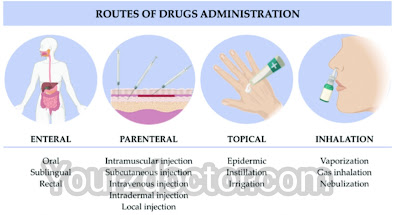Enteral routes (involve GIT)
- Oral route
- Rectal route
- Sublingual route
Parenteral routes (don’t involve GIT)
- Intravenous (IV) route
- Intramuscular (IM) route
- Subcutaneous route
- Topical route (skin or mucus membrane)
- Transdermal route
- Inhalational route
- Intraperitoneal route
- Intracardial route
- Intra-arterial route
- Intrathecal route
- Intra-articular route
- Bone marrow injections
Enteral Routes
Oral Route
Advantages of oral route:
- Most acceptable, convenient, economical and most commonly used route.
- Provides largest surface area for absorption.
- Safest route, drugs can be recovered back by strategies such as emesis or binding to activated charcoal.
- Does not need assistance.
- Can used for local and systemic actions of drugs.
- Drugs that cause irritation or parenteral administration can be given by this route.
- Larger quantity of drug can be given.
Disadvantages of oral route:
- Cannot be used in patients with emergency.
- Cannot be used in unconscious patients.
- Rate of absorption is variable and improper.
- Irritation of mucosal surface can occur.
- Drugs that are poorly lipid soluble (for example neostigmine) are not absorbed.
- Drugs undergoing entero-hepatic circulation (for example epinephrine) are destroyed.
- Any pathological condition of GIT can interfere with the absorption of drugs. For example peptic ulcer.
- Drugs destroyed by digestive enzymes for example insulin or by gastric acidity for example benzyl penicillin cannot be given.
Rectal route:
Advantages of rectal route:
- Can be used when oral administration is impractical e.g. coma.
- Highly irritant drug is given by this route.
- Can be used in vomiting.
- Less entero-hepatic metabolism (about 50% drug will bypass the liver).
Disadvantages of rectal route:
- Imperfect and incomplete absorption.
- Rectal inflammation can occur.
- Patient may feel disgrace.
Sublingual route:
Advantages of sublingual route:
- Rapid absorption occur hence can be used in emergency, for example Nitroglycerine in anginal attacks.
- Drugs do not go into entero-hepatic circulation and first pass effectt does not occur and the drug is absorbed into superior vena cava.
- Convenience of administration.
- Excess drugs can be removed from the mouth.
Disadvantages of sublingual route:
- Large doses cannot be administered.
- Repeated use damages oral mucosa.
Parenteral routes:
Intravenous (IV) route:
Advantages of Iv route:
- There is rapid response and maximum achievements of therapeutic concentrations because drug enters directly into blood so it is the route of emergency.
- Large doses can be given.
- Bio availability is 100%.
- Dose can be accurately delivered.
- Drugs irritant to GIT can be given by diluting them.
Disadvantages of Iv route:
- Excess drugs once administered cannot be recovered back.
- Rapid absorption leads to increased undesirable effects.
- Defective technique cause pain and inflammation.
- There maybe introduction of bacteria through contamination at the site of injection.
- Requires a lot of skills.
- Unsuitable for oily solutions and insoluble substances.
Intramuscular route (IM):
Advantages of intramuscular route (IM):
- Easier for administration than Iv route.
- Quicker absorption than subcutaneous route.
- Suitable for oily drugs.
Disadvantages of IM route:
- Highly irritant drugs cannot be given.
- Insoluble drugs not given because not absorbed.
- Defective technique may lead to damage to nerves or blood vessels.
Note:
Drugs administered IM can be:
Aqueous solutions -> absorption is fast.
Specialized depot preparations -> absorption is slow.
Subcutaneous (SC) route:
Advantages of subcutaneous route:
- Absorption is low so duration of action is prolonged.
- Suitable for some insoluble substances.
Disadvantages of subcutaneous route:
- It end drugs can be produced inflammation, necrosis and pain.
Topical route:
- This route includes application to the skin or the mucous membrane of the eyes, nose, throat, airway or vagina for local effect.
Transdermal route:
- This route use to the skin for systemic effect mostly by the transdermal patch.
- Absorption mostly occurs slowly because of thickness of skin but first pass effect is avoided.
Inhalation route:
- This route is used to produce local effect on lungs or bronchi as in case of asthama and it is also used in general anaesthesia, as the drug is delivered directly to the site of action therefore systemic adverse effects are minimum.
- This route provides rapid delivery of a drug across the large surface area of the mucous membranes of the respiratory tract and pulmonary epithelium, producing an effect almost as rapidly as with IV injections.
- Examples of drugs administered by this route include albuterol and corticosteroids such as the fluticasone.
Learn more
Routes of Drug Administration
There are how many routes of Drug
Administration
Top two routes of Drug Administration
Enteral Routes of Drug Administration
Routes of Drug Administration
What is oral route?
What is rectal route?
What is sublingual route?
Routes of Drug Administration
Parenteral routes of drug Administration
Advantages of oral route
Disadvantages of oral route
Routes of Drug Administration
Advantages of rectal route
Disadvantages of rectal route
Advantages of sublingual route
Disadvantages of sublingual route
Routes of Drug Administration
Advantages of Iv route
Disadvantages of Iv route
Advantages of IM route
Disadvantages of IM route
Routes of Drug Administration
What is topical route?
What is transdermal route?
What is inhalation route?
Routes of Drug Administration






0 Comments